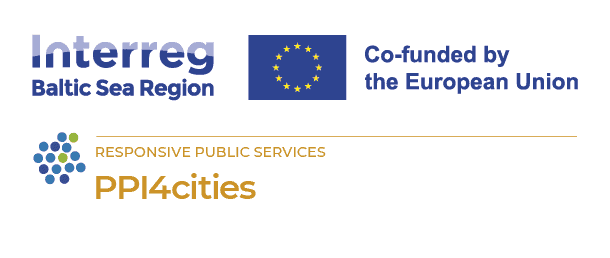
Assessing innovation public procurement: current landscape in PPI4Cities partner countries
13 November 2024
Spending on public procurement is similarly high across countries in the Baltic Sea Region: Finland spends nearly 19% of its GDP, Germany about 18%, and Estonia, Latvia, and Denmark around 14%, while Lithuania spends about 10%. Given this significant purchasing power, the question is whether some of these funds should be directed not toward existing products or services, but toward entirely new or significantly improved ones—in other words, toward innovations.
Experts agree that systematically implementing Innovative Public Procurement (IPP) offers numerous benefits. For public sector organizations, IPP can enhance efficiency and improve the quality of service. From a business perspective, IPP supports the growth of start-ups and the modernization of industrial companies. From a societal viewpoint, IPP fosters the adoption of socially valuable technological solutions.
But what is the status of IPP in the PPI4cities project countries? To answer this question, we can use the “Benchmarking of innovation procurement investments and policy frameworks across Europe” implemented by PwC on behalf of the European Commission. This study examines national IPP policy frameworks and investment levels in IPP across 30 European countries. The study evaluated 10 policy areas, including official definitions, horizontal and sectoral policies, ICT policies, action plans, investment targets, monitoring frameworks, incentives, skill development, and innovation-friendly markets.
In the European rankings of national IPP policies, Finland leads with a score of 70.23%. This means that Finland applies approximately 70% of the 10 policy areas and specific tools identified in the study. Finland performs above the European average in all 10 indicators. Finland has a comprehensive policy framework with a target and an ambitious action plan that is geared to scale up innovation procurement. Yet, further work is needed to reduce the risks and increase incentives for innovation procurement for public buyers, scaling up capacity building to increase the use of variants and preliminary market consultations and to tackle the structural underutilisation of value-for-money award criteria.
The other Baltic countries also perform exceptionally well. Estonia ranks second with a score of 52.43%, exceeding the European average of 33.05% and performing above average on 8 of the 10 indicators. Estonia’s horizontal policies, including public procurement, R&I, and ICT policies, support innovation procurement. However, Estonia lacks an action plan, incentives for procurers, and an impact evaluation system for completed innovation procurements.
Lithuania ranks fifth with a score of 47.24%, a significant improvement from its previous score of 26.6% and 14th place. Lithuania surpasses the European average on 6 of the 10 indicators. The country has set ambitious targets for innovation procurement and has implemented expenditure monitoring and incentives for public buyers. However, support activities are underdeveloped, and criteria like value-for-money and preliminary market consultations are not widely utilized.
Germany is a moderate performer and ranks eighth with a score of 42.97%. It exceeds the European average on 5 of the 10 indicators, with strong support for IPP from ICT and other horizontal policies, such as entrepreneurship and R&D. However, there is room for improvement, as Germany lacks financial incentives for procurers, and its sectoral policies rarely address IPP.
On the other hand, Latvia and Denmark show weaker performances. Latvia ranks 17th with a score of 32.05%, an improvement from 22nd place. However, it remains below the European average, performing below average on 8 of the 10 indicators. Latvia has implemented only about one-third of the policy measures needed for a comprehensive IPP framework.
Denmark ranks 21st with a score of 25.81%. Although Denmark improved its score since the previous benchmark (18.6%), it dropped two positions as other countries advanced faster. Denmark’s ICT policy promotes IPP, and capacity-building measures are underway. However, the policy framework is still in early stages, lacking an action plan, spending targets, and regular monitoring, as well as financial and personal incentives for public buyers.
Regardless of their current performance, each country has room for improvement. The PPI4Cities project supports the advancement of national innovation procurement systems by enhancing the skills of contracting authorities, encouraging networking and collaboration with businesses, and actively pursuing innovative solutions.





